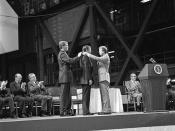Introduction
Music has been known for centuries to have a powerful effect on human responses. In the social science context, music is particularly known for its effectiveness in triggering moods and communicating nonverbally. Many marketing practitioners already accept this notion, given that music is increasingly used as a stimulus in the retail environment as well as in radio and television advertising. Music has been shown to affect consumer behaviours, particularly shopper behaviour (Milliman, 1986), as well as emotional responses (Kellaris and Kent, 1994). Marketers that playing music is in itself not enough, that music needs to be used to target groups in the market place, to differentiate from competitors and to maximise image rather than serving as a distraction. It is therefore not surprising that music has become a major component of consumer marketing, both at the point of purchase and in advertising (Bruner 1990). In this essay we will explore the role of music in advertising.
Advertising
Seidman (1981) reviewed the contributions of music to media productions (movies and educational films), concluding that cognitive and affective comprehension of stimuli can be influenced. Music is a complex chemistry of controllable elements (Bruner, 1990). Unfortunately, no definitive taxonomy of music elements has been developed. Time and pitch-related characteristics appear on almost all lists and also have some empirical confirmation (Kellaris and Kent, 1994). Though less clear, evidence also has been found for a third factor, musical texture (Bruner, 1990).
Advertisers often deliberately try to convey and transfer underlying, yet unasserted, meanings to viewers. The view that an advertisement is a one-way communicative process is a narrow one since one also needs to consider the information processing responses of the receivers as they perceive and interpret messages and images in advertisements (Procter et al 2001). Designers of advertising messages expect viewers...



...
appropriate to your level of education. appropriate length, good grammar, sentence structure, paragraph structure, impressive use of vocabulary and overall an interesting read.
1 out of 1 people found this comment useful.